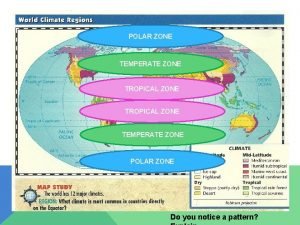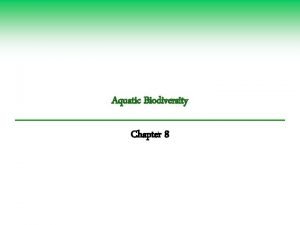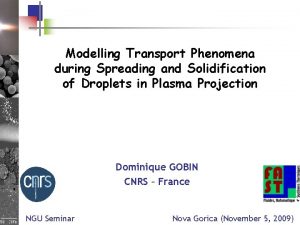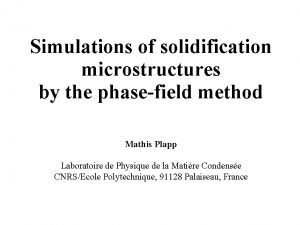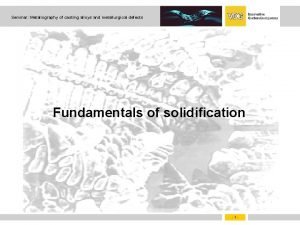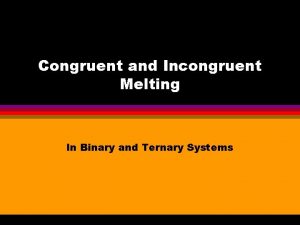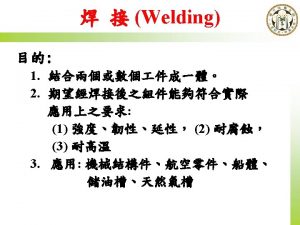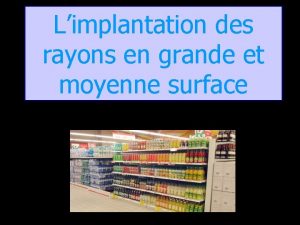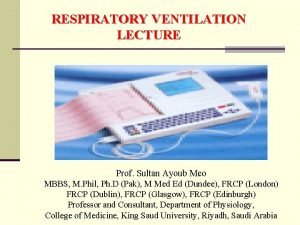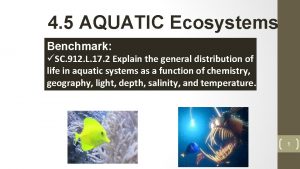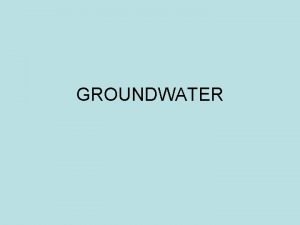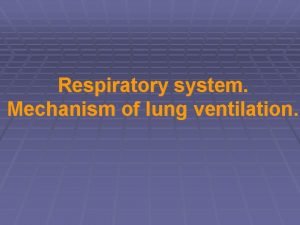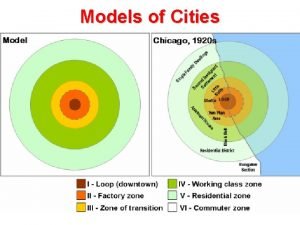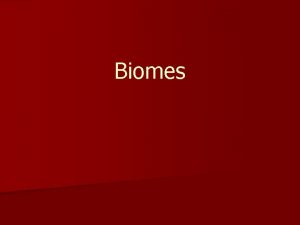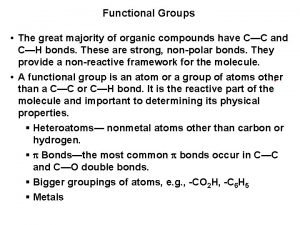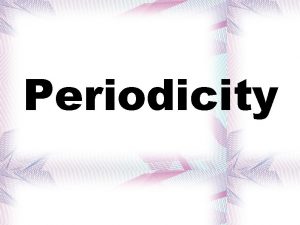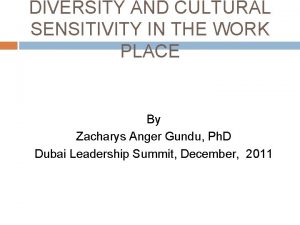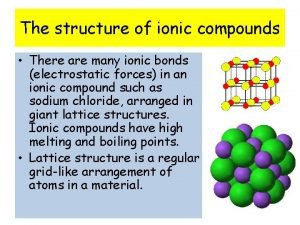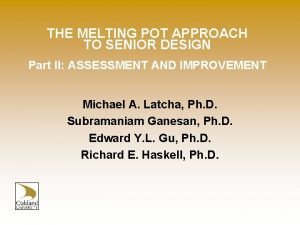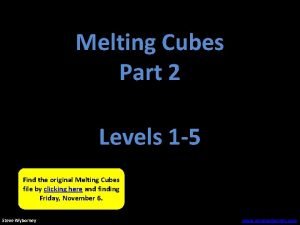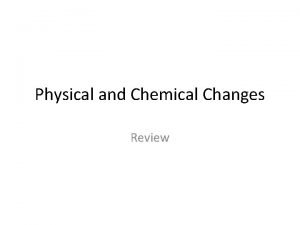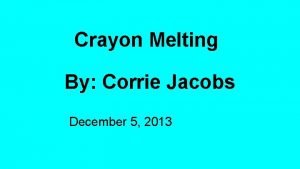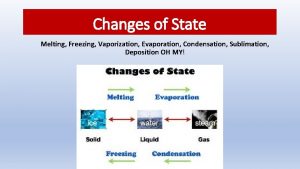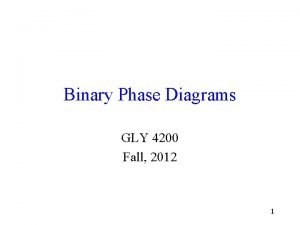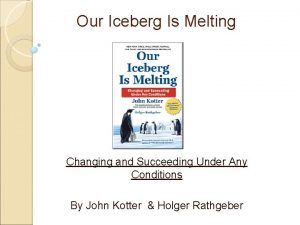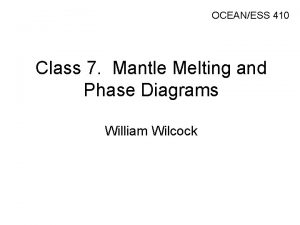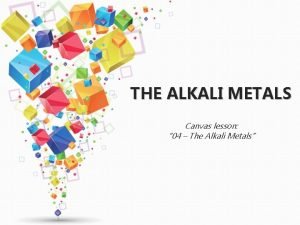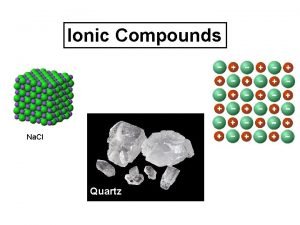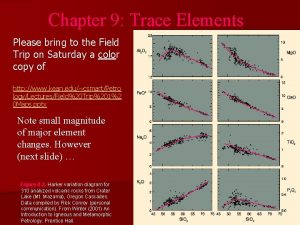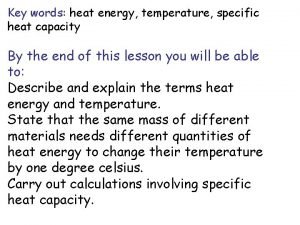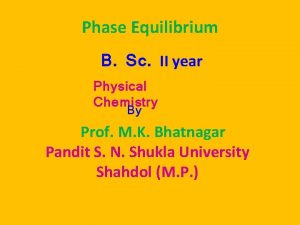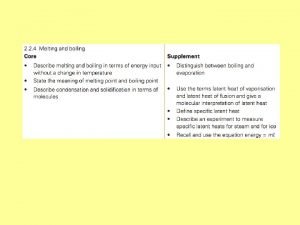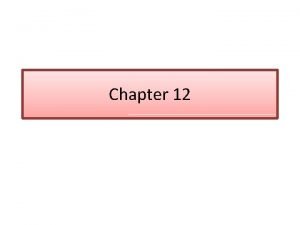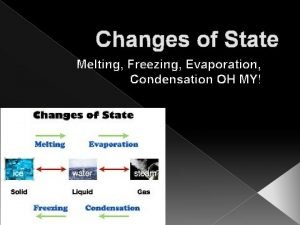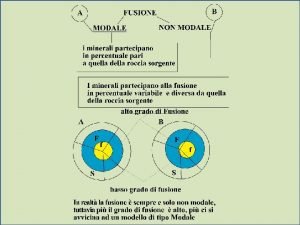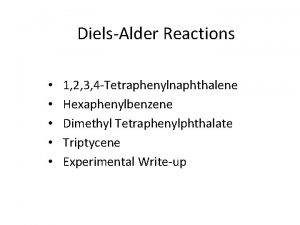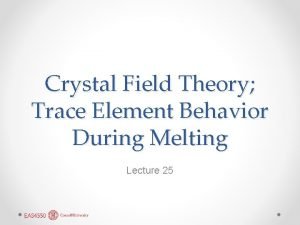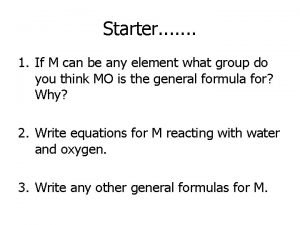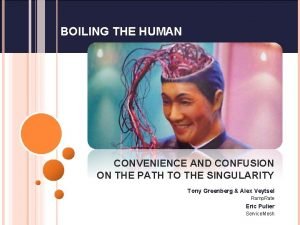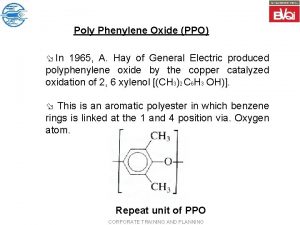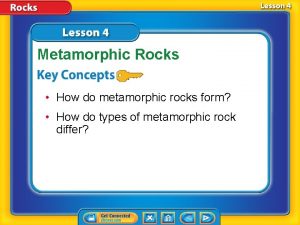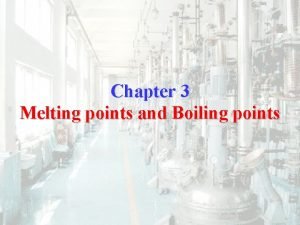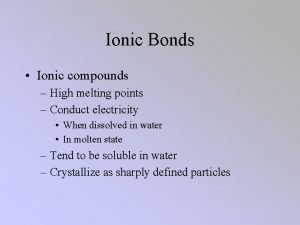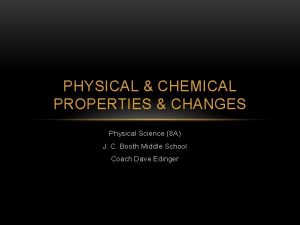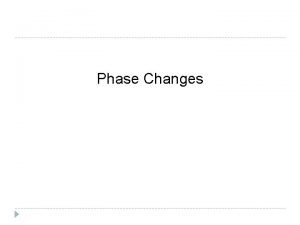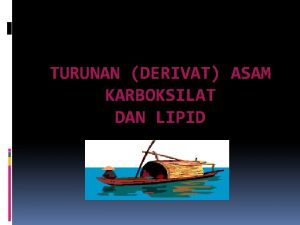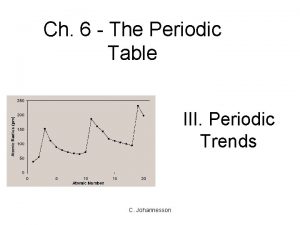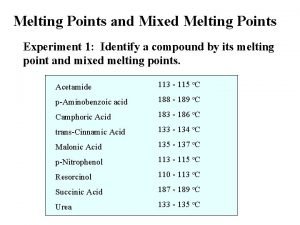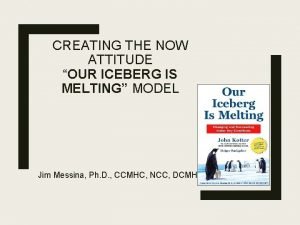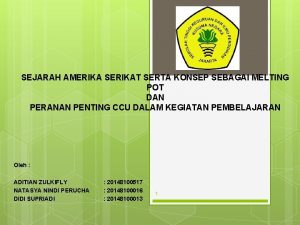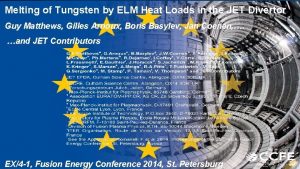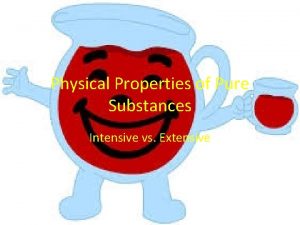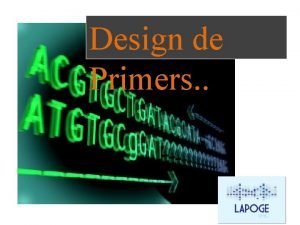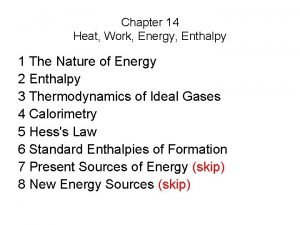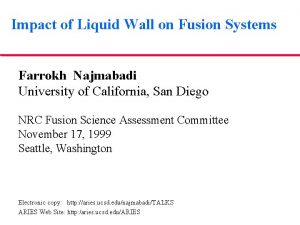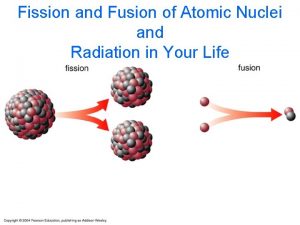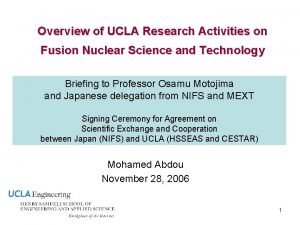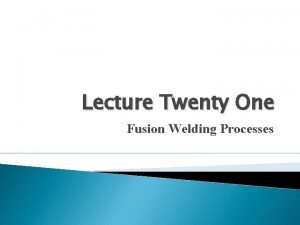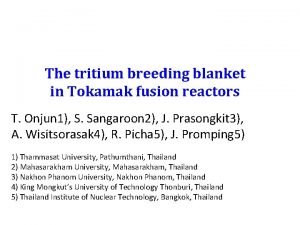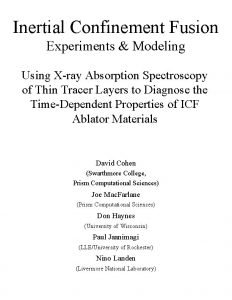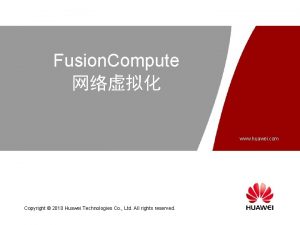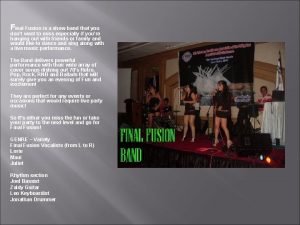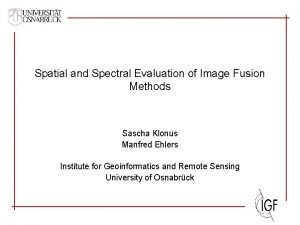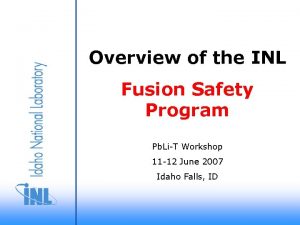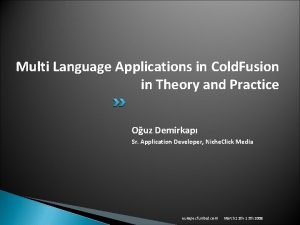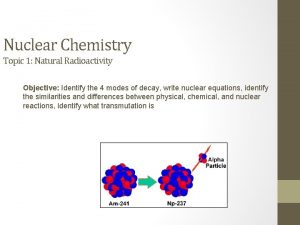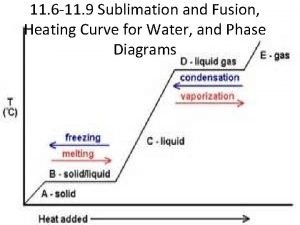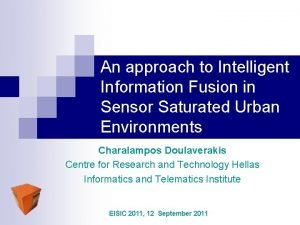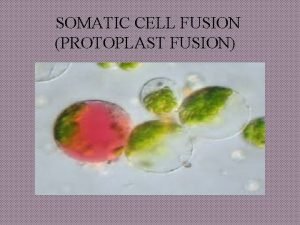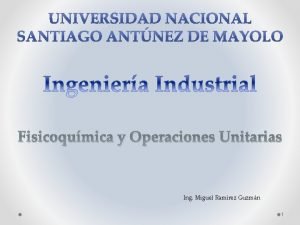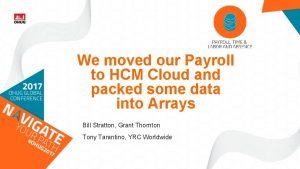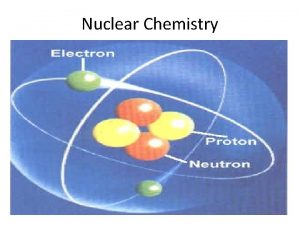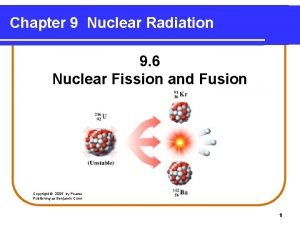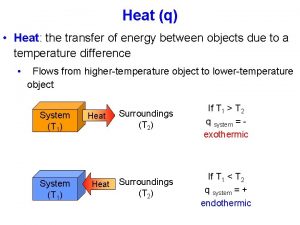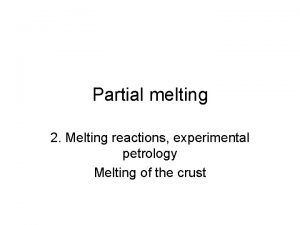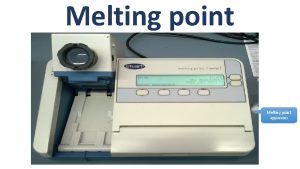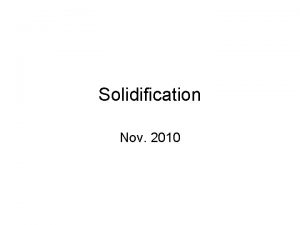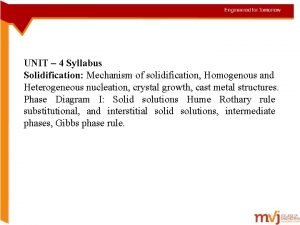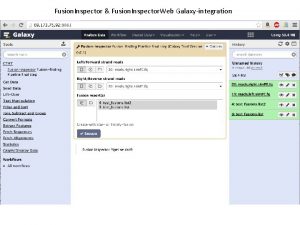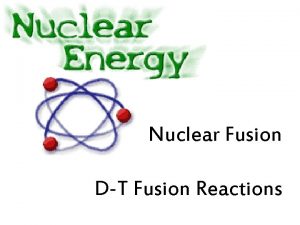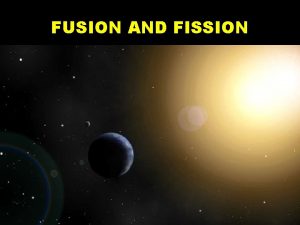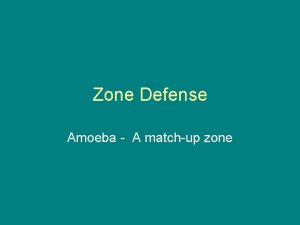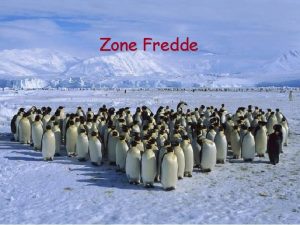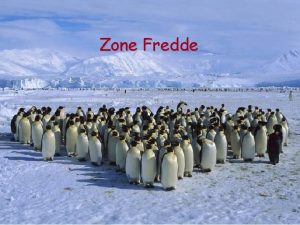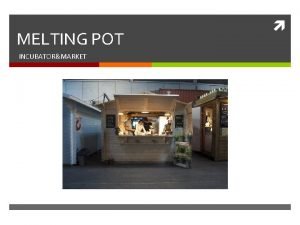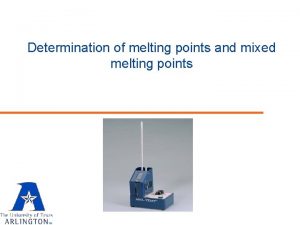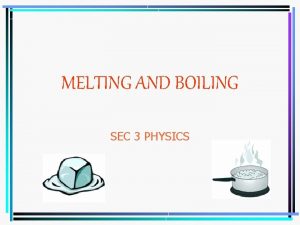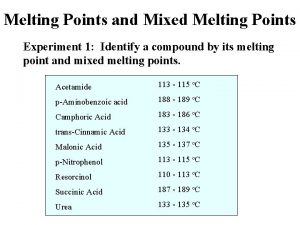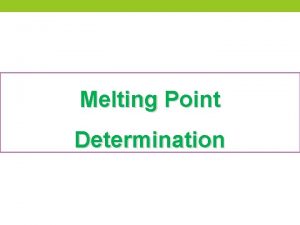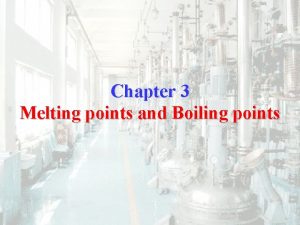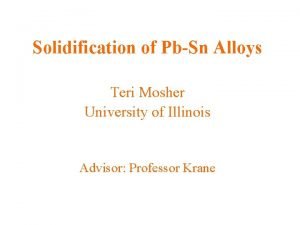1 Fusion Zone T TM Melting Solidification 2







































































































- Slides: 103


焊接相關專業領域 1. Fusion Zone: T > TM (Melting & Solidification) – 凝固理論 2. Heat Affected Zone: T > TC TC:A critical temperature above which mechanical and/or physical properties of the welding alloys will change – 熱處理原理(但程序或溫度變化較激烈) 3. Base Metal: T < TC (No changes in both metallurgical and mechanical properties)

Fig 26 -12

Fusion Weld Zone Figure 29. 1 Characteristics of a typical fusion weld zone in oxyfuel gas and arc welding. See also Figs. 27. 16 and 28. 14.

Fig 26 -10


Welding Engineering / Metallurgy

1. Thermal analysis 瞭解焊件上任何一點(A)在焊接過程中之溫度變化曲線 – Thermal cycle 2. Effects of welding parameters on thermal cycle of HAZ l Welding voltage, E l Welding current, I l Travel speed, S l Preheat temperature l Alloy composition l Section thickness of the workpiece Hi (Heat input ) = (E x I) / S

3. Factors affecting the microstructures and properties of fusion zone • Composition of the filler rod (selection of the filler material) • • % dilution Solidification cooling rate

4. 5. 6. Welding Design • Joint design • Weld type • Stress analysis Welding Methods Inspection & Testing (destructive and nondestructive) Destructive: 拉伸試驗、衝擊試驗、疲勞試驗…。 Non-destructive: 超音波探傷、X光探傷、磁粉探 傷…。

26. 4 Types of Fusion Welds and Types of Joints

Fig. 26 -6


Multiple Pass Deep Weld Figure 27. 6 A deep weld showing the buildup sequence of individual weld beads.

Distortion After Welding Figure 29. 10 Distortion of parts after welding: (a) butt joints; (b) fillet welds. Distortion is caused by differential thermal expansion and contraction of different parts of the welded assembly.

Incomplete Fusion Figure 29. 6 Low-quality weld beads, the result of incomplete fusion. Source: American Welding Society.

Discontinuities in Fusion Welds Figure 29. 7 Schematic illustration of various discontinuities in fusion welds. Source: American Welding Society.

Welding Methods 1. Electrical: Resistance welding Induction welding Electroslag welding Electron beam welding Arc welding Shielded metal arc welding (SMAW) Gas metal arc weldind (GMAW) Gas tungsten arc welding (GTAW) Plasma arc welding (PAW) Submerged arc welding (SAW))

Welding Methods 2. Mechanical: Friction, Ultrasonic, etc. 3. Chemical: Oxy – Acetylene welding, Thermit reaction 4. Optical: Laser beam welding 5. Solid State: Diffusion bonding

一、 Electrical 1. Resistance Welding Processes • Resistance spot welding • Resistance seam welding • Projection welding Mass production

Fig 28 -1

Fig 28 -2

Fig 28 -4

Resistance welding R (resistance): areas to be controlled 1. Contact resistance between electrode and workpiece. 2. The resistance of workpiece itself. 3. Contact resistance between workpieces (希望電阻集中在此處). 4. The resistance of electrode itself.

electrode workpiece

Resistance Spot Welding Figure 28. 5 (a) Sequence in resistance spot welding. (b) Cross-section of a spot weld, showing the weld nugget and the indentation of the electrode on the sheet surfaces. This is one of the most commonly used process in sheet-metal fabrication and in automotive-body assembly.

Fig 28 -5

Fig 28 -3

Resistance Seam Welding Figure 28. 9 (a) Seam-welding process in which rotating rolls act as electrodes. (b) Overlapping spots in a seam weld. (c) Roll spot welds. (d) Resistancewelded gasoline tank.

Fig 28 -9

Fig 28 -8

Resistance Projection Welding Figure 28. 11 (a) Schematic illustration of resistance projection welding. (b) A welded bracket. (c) and (d) Projection welding of nuts or threaded bosses and studs. Source: American Welding Society. (e) Resistanceprojection-welded grills.

Fig 28 -11

Spot Welding Example Figure 28. 8 Robots equipped with spot-welding guns and operated by computer controls, in a mass-production line for automotive bodies. Source: Courtesy of Cincinnati Milacron, Inc.

1. 2 High frequency resistance welding (高週波電阻焊接) ` Frequency: 200 KHz ~ 450 KHz Skin effect:電流集中在表面之程度 Freq.

Fig 28 -10

High-Frequency Butt Welding Figure 28. 10 Two methods of high-frequency butt welding of tubes.

2. Electroslag welding (電熱熔渣焊接) 原理: Electrode is fed into a molten slag pool. An arc is drawn initially but is then snuffed out by the molten slag, and the heat of fusion is provided by resistance heating in the molten slag. Suitable for thick section welding

Electrogas Welding Figure 27. 11 Schematic illustration of the electrogas welding process. Source: American Welding Society.

Fig 28 -21

Equipment for Electroslag Welding Figure 27. 12 Equipment used for electroslag welding operations. Source: American Welding Society.

3. Electron beam welding (電子束焊接) • Heat Source A focused beam of high-velocity electrons which impinge on the workpieces. 動能 (kinetic energy) → 熱能 (heat) • Equipment An electron gun (電子槍) → Generate electrons → Focus them into a beam (聚焦成一電子束) → Accelerate them to a very high speed (加速)

• Some data: 1. Accelerating voltage: 30 ~ 175 k. V 2. Speed: 0. 1 ~ 0. 7 光速 3. Beam current: 50 ~ 100 m. A 4. Beam spot size: 0. 25 ~ 0. 75 mm

• Degree of Vacuum (in operation) High Vacuum --- 10 -3 ~ 10 -6 torr Medium Vacuum --- 10 -3 ~ 25 torr Non-Vacuum --- Atmosphere (760 torr) (1 torr = 1 mm. Hg)

28 -22 Fig 28 -22

Advantages: 1. Max. weld penetration (H/D: 25/1) 2. Minimum weld width (HAZ) 3. Minimum weld shrinkage in HAZ and workpieces 4. Maximum weld purity

Disadvantages: 1. Equipment costs are high 2. Chamber size limits the size of workpieces 3. Production rate is low

28 -23 Fig 28 -23

Tab 28 -4 TABLE 28 -4

1. Friction Welding (a) (b) Figure 28. 3 (a) Sequence of operations in the friction welding process: (1) Lefthand component is rotated at high speed. (2) Right-hand component is brought into contact under an axial force. (3) Axial force is increased; flash begins to form. (4) Left-hand component stops rotating; weld is completed. The flash can subsequently be removed by machining or grinding. (b) Shape of fusion zone in friction welding, as a function of the force applied and the rotational speed.


Fig 28 -15

28 -16

28 -17

二、Mechanical 2. Ultrasonic welding (超音波焊接) • Transducer (變能器) 10 KHz ~ 75 KHz (High frequency vibration) • Welding mechanism: – Static normal stress + Oscillating shearing stress – (Plastic deformation + Solid state bonding)

Fig 28 -19

Ultrasonic Welding (a) (b) Figure 28. 2 (a) Components of an ultrasonic welding machine for lap welds. The lateral vibrations of the tool tip cause plastic deformation and bonding at the interface of the workpieces. (b) Ultrasonic seam welding using a roller. (c) An ultrasonically welded part.

28 -18

三、Optical Laser beam welding (雷射束焊接) (Light Amplification by Stimulated Emission of Radiation) heat light Electrical Chemical Thermal Optical Nuclear Coherent Electromagnetic radication energy absorbed Lasing material: 固體:Cr, Ruby, 鈾 氣體:He, N 2, CO 2 Excitation of a specific energy level


Fig 28 -25

Fig 28 -26

Tab 28 -5 TABLE 28 -5

Diffusion bonding Diffusion: movements of atoms across the interface between two workpieces to be welded — produces chemical bonds 焊接參數: 1. 溫度 ~ 約0. 5 Tm (o. K) 2. 壓力 (clamping force) 3. 時間 4. 二接觸表面之清靜度 應用: 1. 不同種類之金屬材料 2. 難焊接之材料 3. 複合材料 e. g. Ti alloys, superalloys, etc.


Diffusion Bonding/Superplastic Forming Figure 28. 17 The sequence of operations in the fabrication of various structures by diffusion bonding and then superplastic forming of (originally) flat sheets. Sources: (a) After D. Stephen and S. J. Swadling. (b) and (c) Rockwell International Corp.

Arc Welding • • • Shielded Metal Arc Welding (SMAW) Gas Metal Arc Welding (GMAW) Gas Tungsten Arc Welding (GTAW) Plasma Arc Welding (PAW) Submerged Arc Welding (SAW)

Power supply AC: Alternating current DC: Direct current Eo:transformer output voltage EL:reactance voltage drop ER:load(welding)voltage drop

A simple R - L circuit

ω:angular freq. of the sine function for 60 cycle AC line supply = 376. 8 rad. /sec θ:phase angle, θ =

Reactance (L): (1) produce a phase shift (θ) (2) control V-C characteristics

(1) constantant voltage (2) constant current

Half-wave rectifier circuit

Full-wave rectifier circuit filter (a) E(t)→D 2→L→R→D 3→E(t) (b) E(t)→D 4→L→R→D 1→E(t)

Choke: a variable inductor (the inductance retards the rate of current rise when the arc is being started)

27. 1 Arc Welding • An arc between two electrodes was a concentrated heat souse that could approach 4000°C. • Current 1 to 4000 A (large) Voltage 20 to 50 V (low)


Shielded Metal-Arc Welding Figure 27. 4 Schematic illustration of the shielded metal-arc welding process. About 50% of all largescale industrial welding operations use this process. Figure 27. 5 Schematic illustration of the shielded metal-arc welding operations (also known as stick welding, because the electrode is in the shape of a stick).

Fig 27 -1

Fig 27 -4

Fig 27 -5

TABLE 27 -1

Flux-Cored Arc-Welding Figure 27. 10 Schematic illustration of the flux-cored arcwelding process. This operation is similar to gas metal-arc welding, showing in Fig. 27. 8.

27 -6

TABLE 27 -2

Gas Metal-Arc Welding Figure 27. 8 Schematic illustration of the gas metal-arc welding process, formerly known as MIG (for metal inert gas) welding.

Fig 27 -7

In order to maintain a constant arc gap wire melt-off rate = wire feed speed (dynamic equilibrium) .gap arc voltage .wire melt-off rate arc current


TABLE 27 -3

Gas Tungsten-Arc Welding Figure 27. 13 The gas tungsten-arc welding process, formerly known as TIG (for tungsten inert gas) welding. Figure 27. 14 Equipment for gas tungsten-arc welding operations. Source: American Welding Society.

27 -12

Comparison of Laser-Beam and Tungsten-Arc Welding Figure 27. 16 Comparison of the size of weld beads in (a) electron-beam or laser-beam welding to that in (b) conventional (tungsten-arc) welding. Source: American Welding Society, Welding Handbook (8 th ed. ), 1991.

TABLE 27 -5

Plasma-Arc Welding Figure 27. 15 Two types of plasma-arc welding processes: (a) transferred, (b) nontransferred. Deep and narrow welds can be made by this process at high welding speeds.

TABLE 27 -6

Submerged-Arc Welding Figure 27. 7 Schematic illustration of the submerged-arc welding process and equipment. The unfused flux is recovered and reused. Source: American Welding Society.

Fig 27 -8

TABLE 27 -4

28. 8 Welding-Related Processes • Surfacing process of depositing a layer of weld metal on the surface or edge of a base material of different composition • Thermal spray coating or metallizing offer a means of applying a coating of high -performance material (metals, alloys, ceramics, intermetallics, ceramets, carbides, or even plastics)

Fig 28 -30

Fig 28 -31

TABLE 28 -6
 Polar tropical
Polar tropical Intertidal ocean zone
Intertidal ocean zone Source zone transition zone and floodplain zone
Source zone transition zone and floodplain zone Solidification
Solidification Solidification
Solidification Casting
Casting Congruent vs incongruent melting
Congruent vs incongruent melting Resistance arc welding
Resistance arc welding Zone chaude zone froide supermarché
Zone chaude zone froide supermarché Conducting zone vs respiratory zone
Conducting zone vs respiratory zone Photic zone and aphotic zone venn diagram
Photic zone and aphotic zone venn diagram Zone of aeration and zone of saturation
Zone of aeration and zone of saturation Zone 1 and zone 2
Zone 1 and zone 2 Stretched nostrils
Stretched nostrils Zone of aeration and zone of saturation
Zone of aeration and zone of saturation Concetric zone model
Concetric zone model What is the conducting zone of the respiratory system
What is the conducting zone of the respiratory system Climate latitude
Climate latitude Ion solvent interaction
Ion solvent interaction Melting pot
Melting pot Chemical vs physical change
Chemical vs physical change Melting point of group 2
Melting point of group 2 Melting pot
Melting pot Ionic bonds brittle
Ionic bonds brittle Melting and boiling point of oxygen
Melting and boiling point of oxygen Is a sparkler a chemical or physical change?
Is a sparkler a chemical or physical change? Usa melting pot or salad bowl
Usa melting pot or salad bowl Faster chocolate
Faster chocolate Melting pot approach
Melting pot approach Oxbridge melting pot
Oxbridge melting pot Melting cubes
Melting cubes Kenetic particle theory
Kenetic particle theory Is fogging a mirror with your breath physical or chemical
Is fogging a mirror with your breath physical or chemical Hypothesis for melting crayons
Hypothesis for melting crayons Freezing melting evaporation condensation sublimation
Freezing melting evaporation condensation sublimation Congruent melting point
Congruent melting point Our iceberg is melting exercises
Our iceberg is melting exercises Sitting there like a wax doll melting in its own heat
Sitting there like a wax doll melting in its own heat Melting pot gilded age
Melting pot gilded age Olivine melting point
Olivine melting point Group 1 melting point trend
Group 1 melting point trend Melting pot
Melting pot Melting time
Melting time High melting point
High melting point Batch melting equation
Batch melting equation How to find the specific heat capacity
How to find the specific heat capacity Melting madder
Melting madder Congruent melting point definition
Congruent melting point definition Latent heat
Latent heat Opposite of melting
Opposite of melting Condensation evaporation melting freezing
Condensation evaporation melting freezing Melting pot vs salad bowl
Melting pot vs salad bowl Batch melting
Batch melting Dimethyl tetraphenylphthalate
Dimethyl tetraphenylphthalate Batch melting
Batch melting Melting pot and salad bowl
Melting pot and salad bowl Physical properties of group 2 elements
Physical properties of group 2 elements Tony greenberg ramprate
Tony greenberg ramprate Polyphenylene oxide applications
Polyphenylene oxide applications Regional metamorphism
Regional metamorphism Ice cube aon
Ice cube aon Hoch2oh boiling point
Hoch2oh boiling point Why do ionic compounds have high melting and boiling points
Why do ionic compounds have high melting and boiling points Cream being whipped physical or chemical change
Cream being whipped physical or chemical change Phase changes in matter
Phase changes in matter Fantasy surrealism
Fantasy surrealism Ice melting
Ice melting Melting point of carboxylic acid derivatives
Melting point of carboxylic acid derivatives Melting point periodic table trend
Melting point periodic table trend Melting point of diamond
Melting point of diamond Mixed melting point definition
Mixed melting point definition Iceberg is melting summary
Iceberg is melting summary Melting point of water
Melting point of water Konsep melting pot
Konsep melting pot Tungsten melting pot
Tungsten melting pot Mass defintion
Mass defintion Is boiling point intensive or extensive
Is boiling point intensive or extensive Temperatura de melting primers
Temperatura de melting primers Enthalpy of melting of ice
Enthalpy of melting of ice Fusion energy sciences
Fusion energy sciences Fusion fission
Fusion fission Ucla fusion
Ucla fusion Fusion arc welding
Fusion arc welding Fusion reactor diagram
Fusion reactor diagram Fusion medical staffing llc
Fusion medical staffing llc Que es hicloud
Que es hicloud Luna_xuany
Luna_xuany Inertial confinement fusion lasers
Inertial confinement fusion lasers Huawei fusion compute
Huawei fusion compute Final fusion
Final fusion Fusion
Fusion Cold compression machine for suppositories
Cold compression machine for suppositories Fusion safety management
Fusion safety management Adobeü
Adobeü Nuclear fission and fusion similarities
Nuclear fission and fusion similarities Heating curve sublimation
Heating curve sublimation Fusion llf
Fusion llf Chemo fusion and electrofusion are employed in
Chemo fusion and electrofusion are employed in Calor latente de fusion y evaporacion
Calor latente de fusion y evaporacion Oracle fusion payroll implementation guide
Oracle fusion payroll implementation guide Fusion nuclear
Fusion nuclear Nuclear fission radiation
Nuclear fission radiation Fission and fusion similarities
Fission and fusion similarities Water heating curve
Water heating curve
